So a few years back, Minaal debuted with a massively successful Kickstarter campaign, funding a carry-on sized backpack designed for digital nomads and other lightweight travelers who only ever bring one bag. It’s been on my list of favorite travel backpacks ever since.
But competition has heated up since then, as more and more people realize that hauling a coffin-sized suitcase up a flight of stairs is a terrible idea. So Minaal has been hard at work on version 2.0, building on the original design with a number of seemingly-tiny details that add up to some major conveniences. It was already good, but now it’s even better. The video of them frolicking with their bag on the Kickstarter page was pretty fun too.
I’ve had my eye on this one for a long time, due to the size, features, and the professional appearance, and they sent me an early sample before the final production phase for testing and feedback (meaning there might be tiny differences between this one and the final version, but probably nothing noticeable). But enough about me. Let’s just get to it.
Minaal Carry-on Backpack 2.0
Here it is:
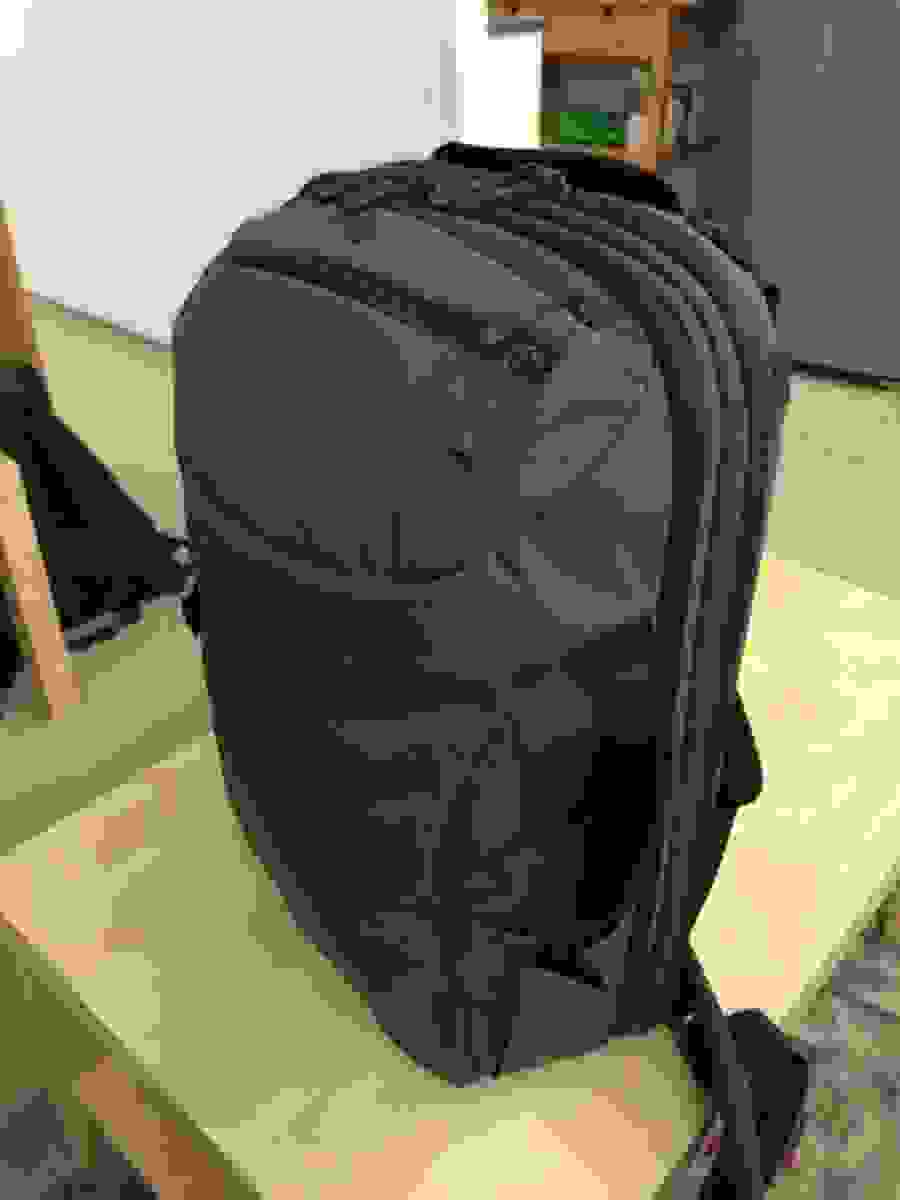
Stats
Stupid American numbers:
- Height: 21.65″
- Width: 13.77″
- Depth: 7.87″
- Weight: 3 lbs, 10 oz (including rain cover and hip belt)
- Capacity: 35 liters (yes, Americans sometimes use liters too)
Civilized metric units:
- Height: 55 cm
- Width: 35 cm
- Depth: 20 cm
- Weight: 1.64 kg (including rain cover and hip belt)
- Capacity: 35 liters
Price: $300
(The rain cover is included, but I think the hip belt will be sold separately. You’ll probably want it, though.)
The first thing you might notice is that it’s smaller than other maximum-sized carry-ons, which is deliberate; certain budget airlines in Europe have smaller luggage allowances than most North American airlines, making this a global carry-on, rather than just a North American one. If you can get by with less gear, you’ll gain the convenience of never having to check a bag. Also, the dimension that’s reduced most significantly is depth, meaning the weight will stay close to your back, just as it should.
What it looks like
Here’s the front:
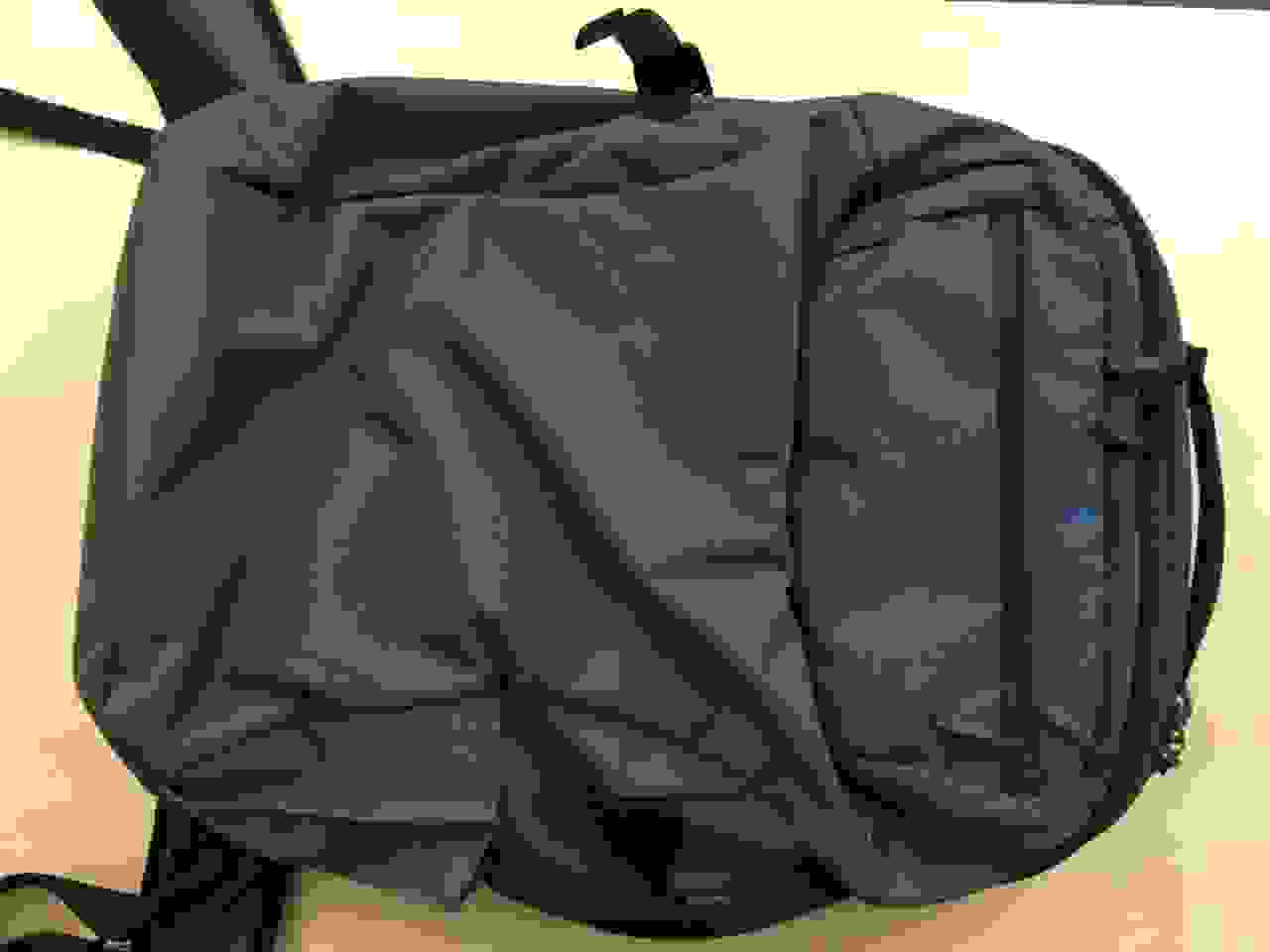
This is the side that’s most likely going to end up flat on the ground, so it’s nice that it’s clean and unadorned.
Here’s the back panel:
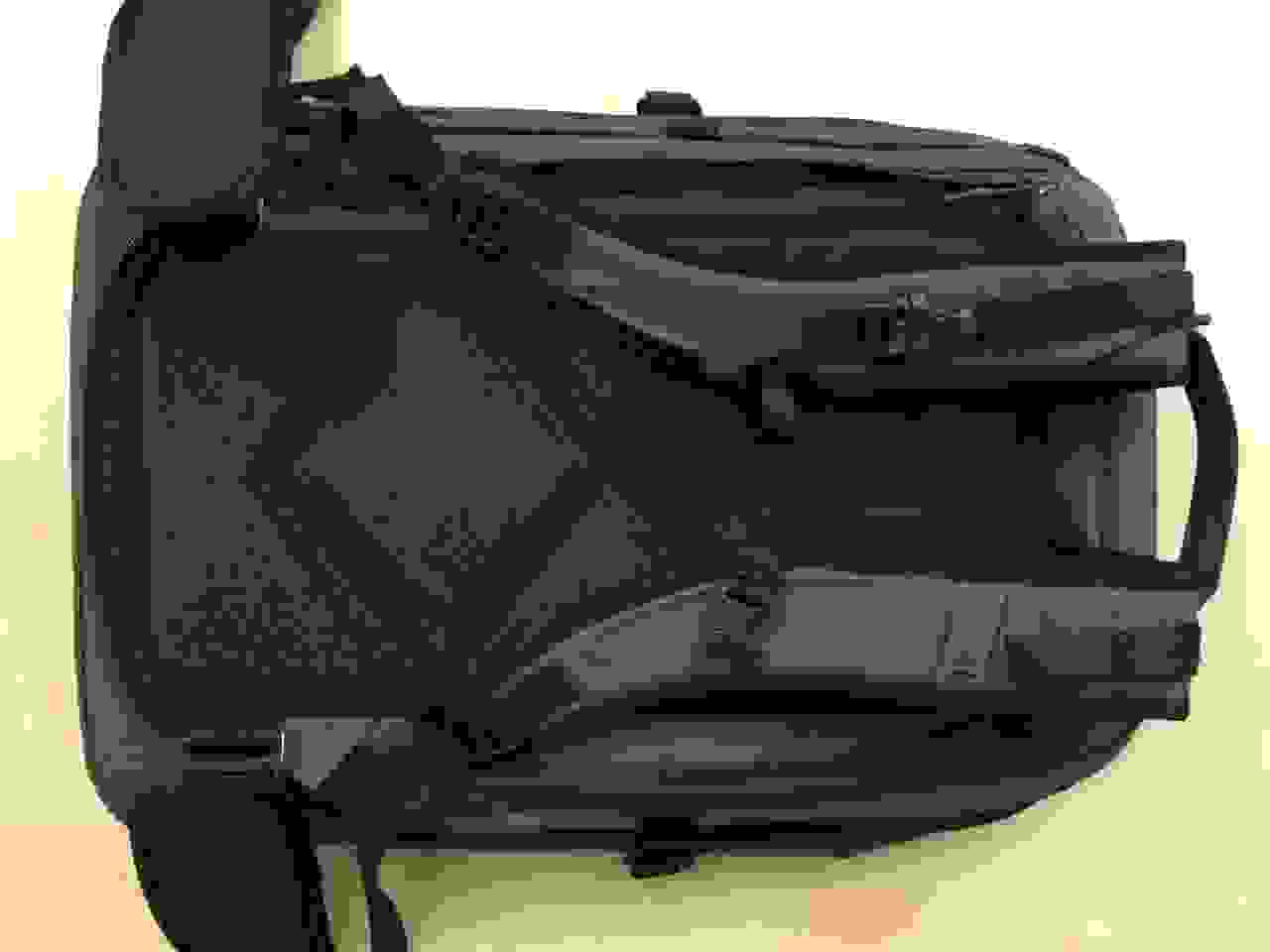
Details worth noticing here include the cutouts in the back panel foam, which allow a bit of air circulation, and the clip to keep the sternum strap out of the way when you’re not using it. You can also clip things onto that strap that says “Minaal” on the left shoulder strap. It’s a good place for sunglasses, for example.
Here’s a view from the side (which is the top, when carried like a suitcase).

Here’s the other side (or the bottom, when carried like a suitcase, so there’s no pocket on this side):

While we’re over here, you might notice one of the major changes to this version of the pack, which is how the side compression straps no longer use a quick-release buckle (the type used on the sternum and waist strap), but instead use a metal hook, which attaches to a small loop of nylon webbing. This not only allows for more compression, but the hook can be fixed in two positions; over the zippers, or out of their way:
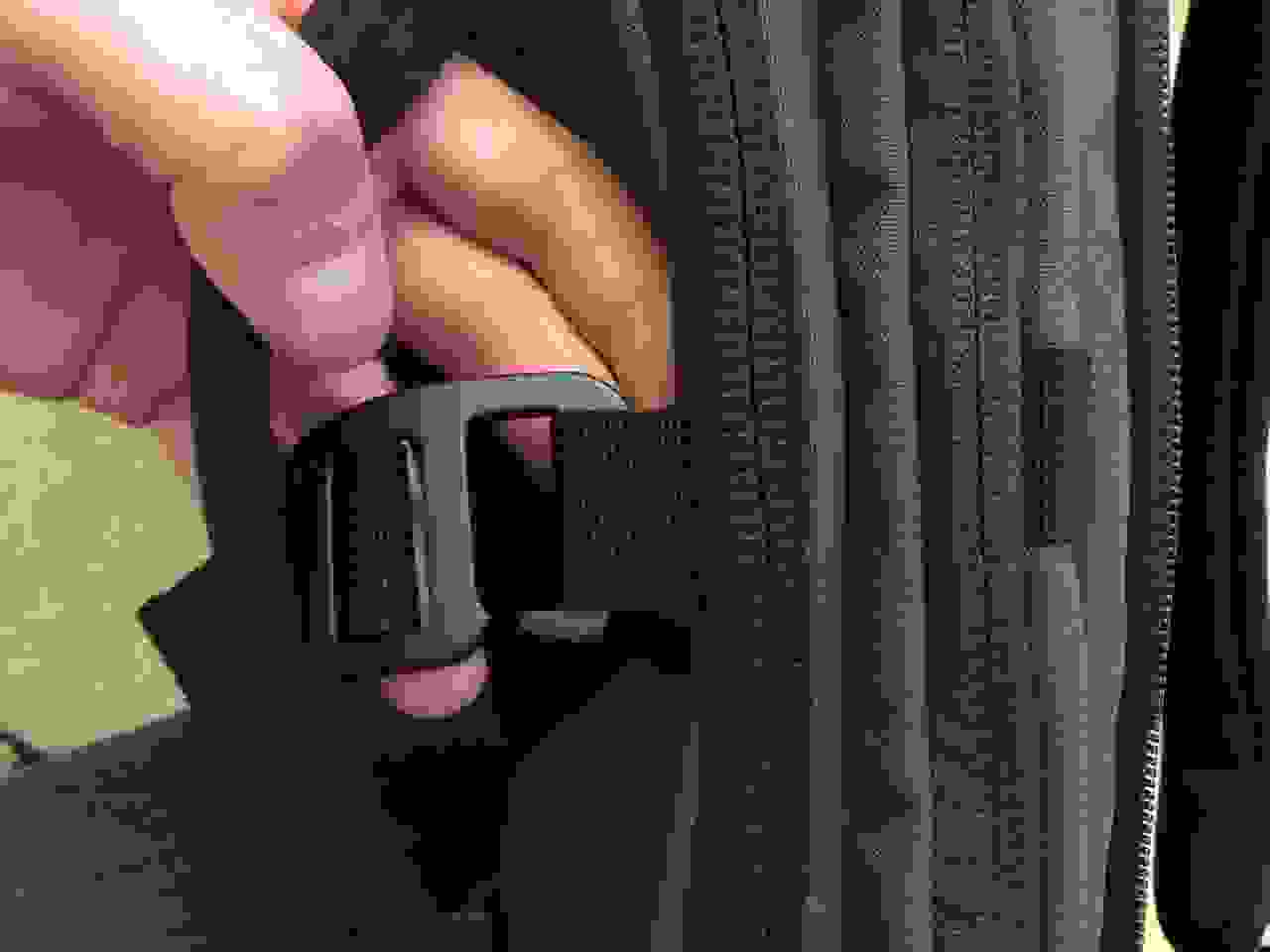
While the original version required you to unclip the buckles to open up the pack, this version does not. The only time you might want to hook it all the way over is if you’ve overpacked, and you want to take some of the stress off the zippers. Aside from that, you can just leave the hooks clipped on that side forever, and never deal with them ever again. Despite being a simple clip update, it’s a major simplification.
What’s inside
Before we open things up, notice how the main compartment and laptop compartment both have locking zippers, and they’re close enough together to use the same lock:

And yes, there’s a technique that allows thieves to open a zipper, even if it’s locked. It’s very annoying. But if you loop the lock through that grab handle, at least they won’t be able to hide the evidence. Just remember that nothing is ever 100% secure, but locking zippers are such an easy feature to include that I think it’s good to have them available.
Okay, moving on. Here’s one of the defining features of any good travel backpack: The ability to open up like a suitcase. If you’ve ever needed to dig something out of the bottom of a top-loading mountaineering pack, you’ll know how big a deal this is.
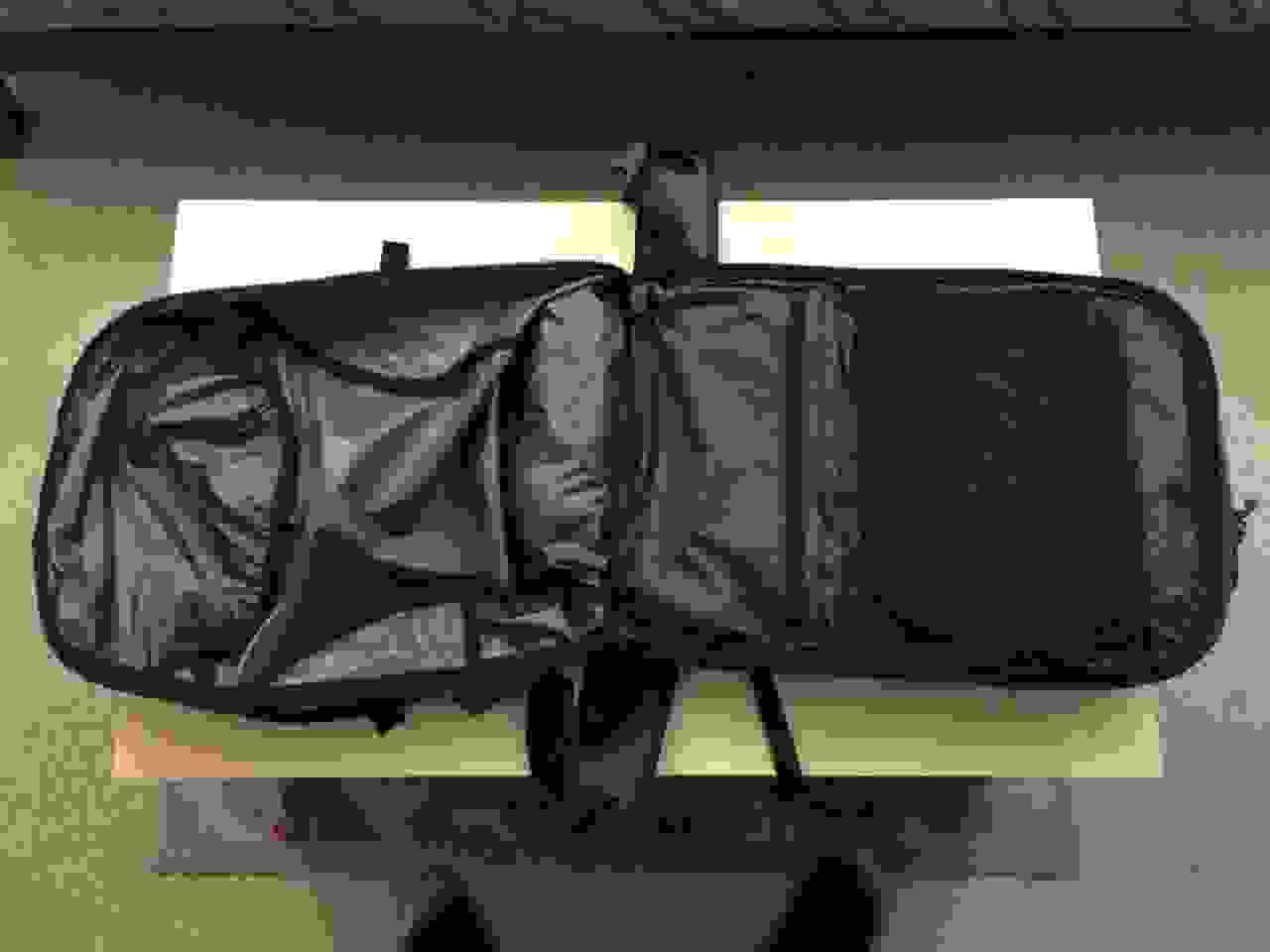
Speaking of organization, another major change with this version is that the two zippered pockets on the right are now three-dimensional, making them much more spacious than before. They’re basically built-in packing cubes now.

This is actually even more helpful than you might imagine, because it mitigates one of the only potential issues with the overall design; because the main compartment is just one giant pocket with soft-sided walls, it has a tendency to collapse. It can be tricky to zip shut without small items falling out, whereas a backpack with more rigid walls wouldn’t do that. You can solve this problem with packing cubes, but with these are built right in, the overall design is now a lot more functional.
Since they have straight zippers instead of U-shaped zippers, I’d say they’re better at storing a few medium-sized items, rather than lots of little things. It can be difficult digging to the bottom of each pocket if all you pack in there is a bunch of socks, for example. It’s not a bad idea to use at least one “real” packing cube for smaller items in addition to the built-in pockets, and they’ve announced custom-sized packing cubes that’ll be available for this.
Moving on to the laptop compartment:

It might be hard to see them all, but there are actually five compartments in there. On the bottom of the photo, you’ll see both a laptop sleeve and a tablet sleeve (both of which can be accessed either from the top or the side of the bag, which is a nice new feature). On the opposite side, there’s a document sleeve, for holding papers and notebooks, with a separate passport pocket inside. Lastly, there’s a zippered compartment just to the right, which is long and skinny, for pens, pencils, and maybe some cables.
A couple dedicated pen and pencil slots would have been useful, though you can use the passport pocket or the zippered compartment for those pretty easily. Also, I thought it might be good to have this compartment open up with a U-shaped zipper as well, but apparently testers said it was too big and floppy, so they stuck with the L-shaped one.
Transforming from suitcase to backpack
One of the major features of the bag is how the straps can be zipped away, so they’re better protected in case you need to send it through as a checked bag:
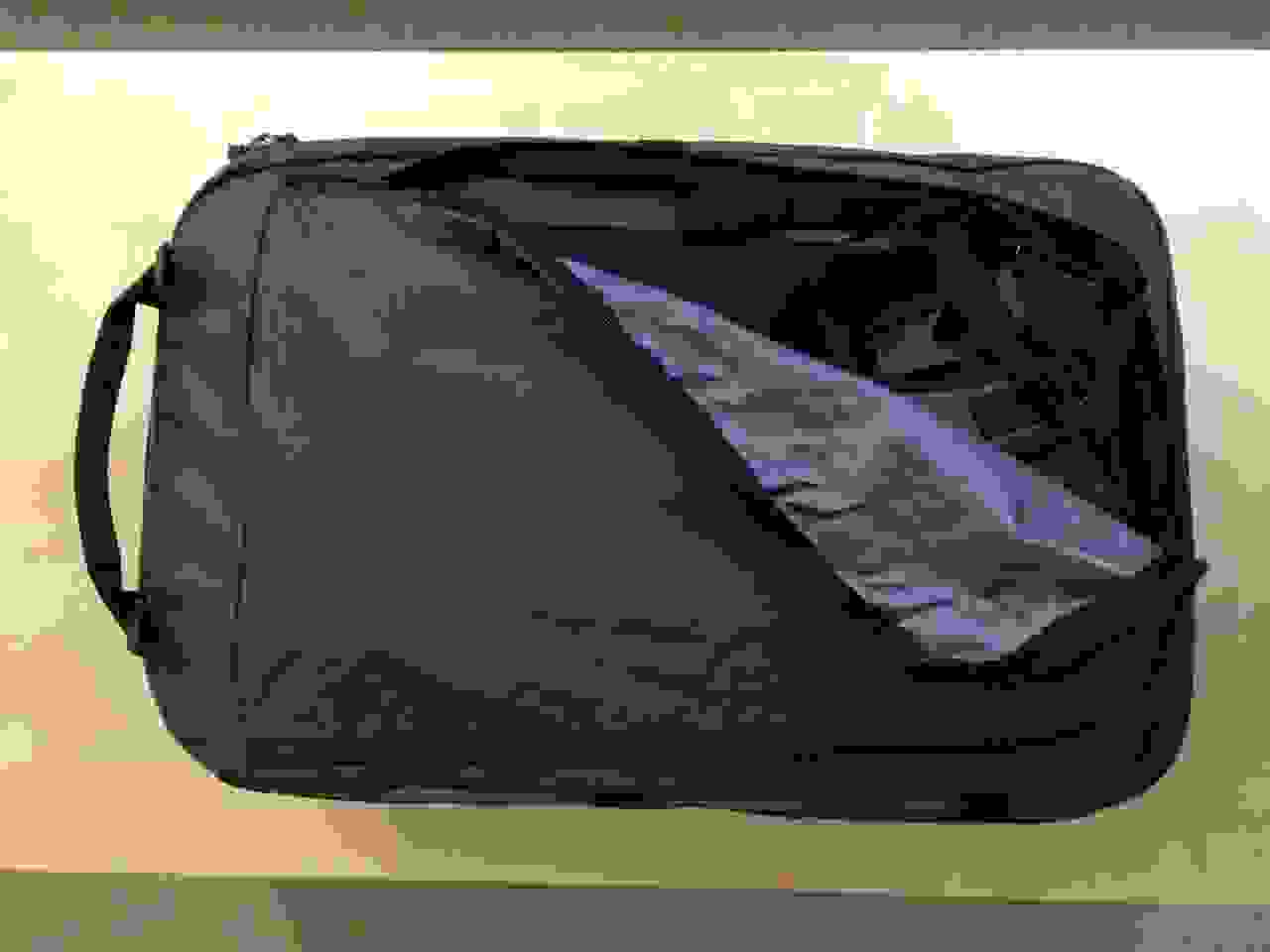
That panel is made of the same tough Cordura nylon as the rest of the bag, so the shoulder and hip straps won’t get snagged during transit.
When you convert it back to a backpack, you roll that panel up and tuck it back just above the shoulder straps, then clip these straps over it, which in this version are now magnetized:

Not only do the magnetized clips snap themselves into place, but the clips are also directional, kind of like hooks; with the straps pulling them tightly in one direction, they’ll stay in place, but all you have to do to detach them is push them the other way. This is a dorky thing to get excited about, but if you have to convert it back and forth from a backpack to a suitcase over and over again, you’re going to love this. It literally could not be simpler.
While we’re on the subject of straps, another major addition is the optional padded hip belt. It clips into an unobtrusive loop of nylon webbing, like this:
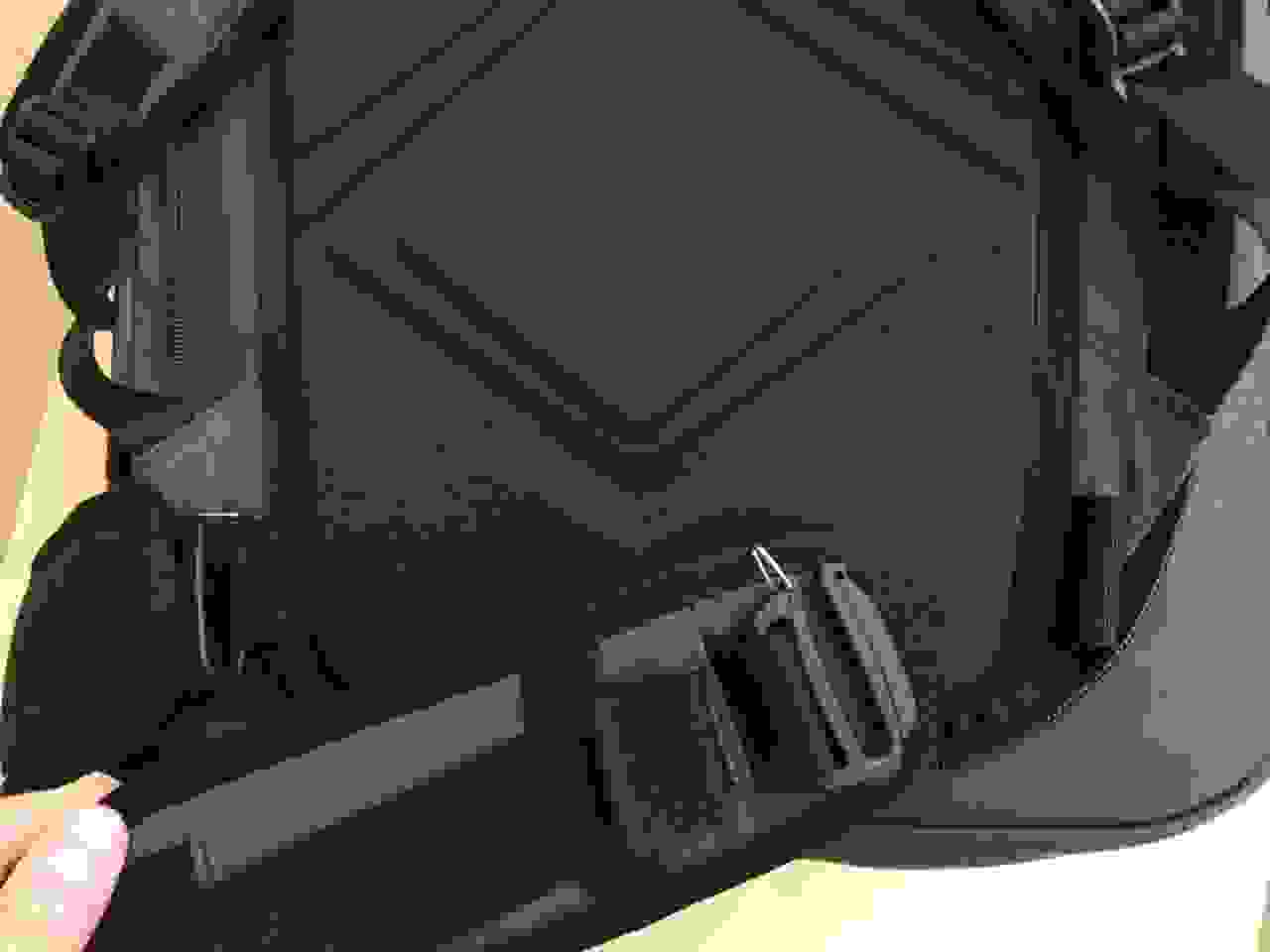
It definitely feels like a “real” hip belt, and I expect for users of the original version (which had a non-padded hip belt), it’ll be a welcome change. It feels comfortable, and the clips are really easy to operate, while still feeling secure. And if you decide not to use the hip belt, all that’s left behind is a tiny loop of fabric that won’t get in the way.
Outside pockets
Not counting the main compartment or the laptop compartment, this bag features three pockets accessible from the outside (unless you count the rain cover compartment, which would be a fourth), which are helpful for storing small items that you need to grab quickly.
Along the side is the water bottle pocket, made of a tough fabric instead of mesh, so it’ll last longer. It also has an adjustable, elastic cord to hold things snugly, regardless of size:
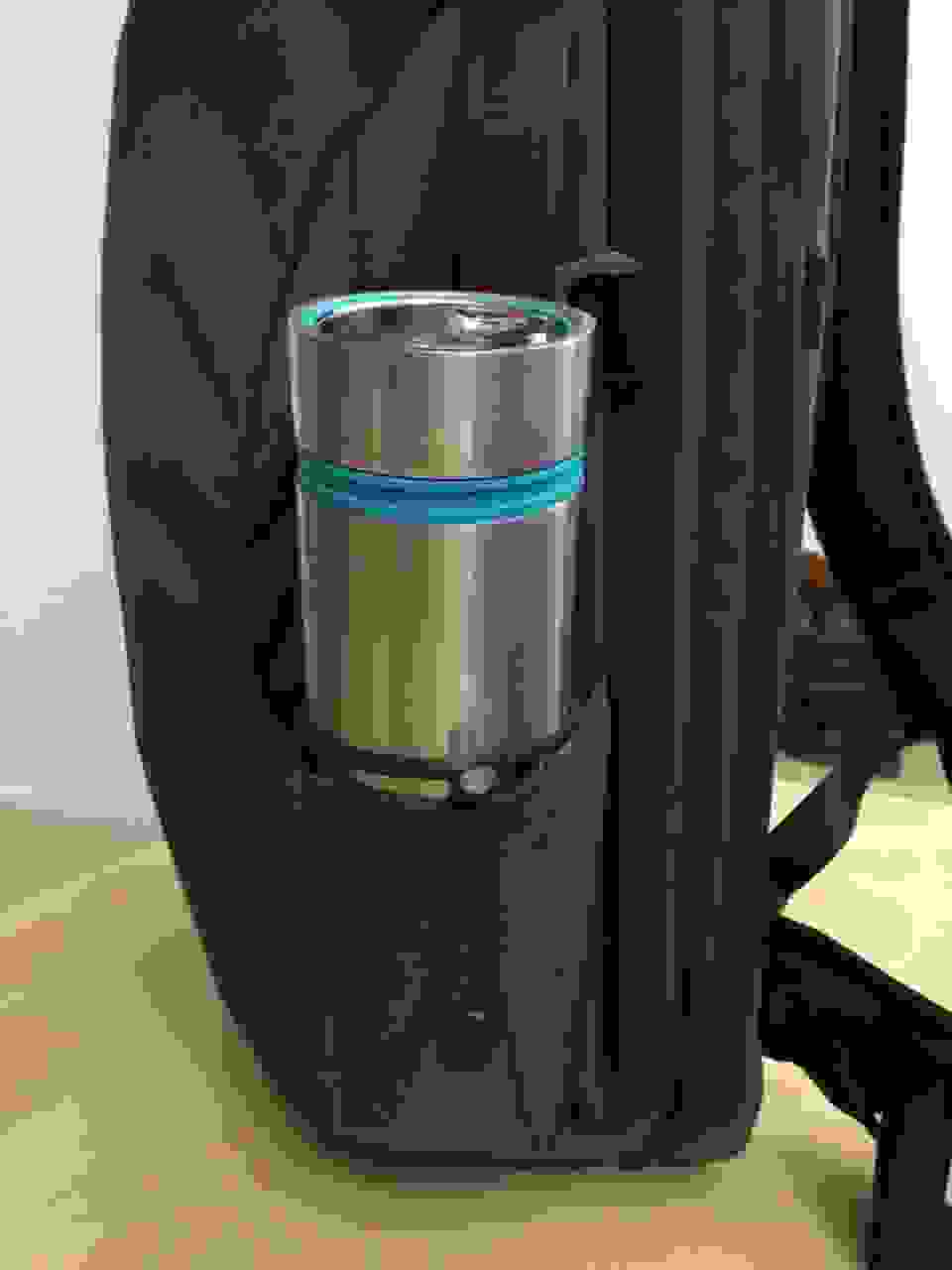
At first I thought that a conventional pocket with an elastic band sewn across the top would have worked better, but then I was informed of this little trick:
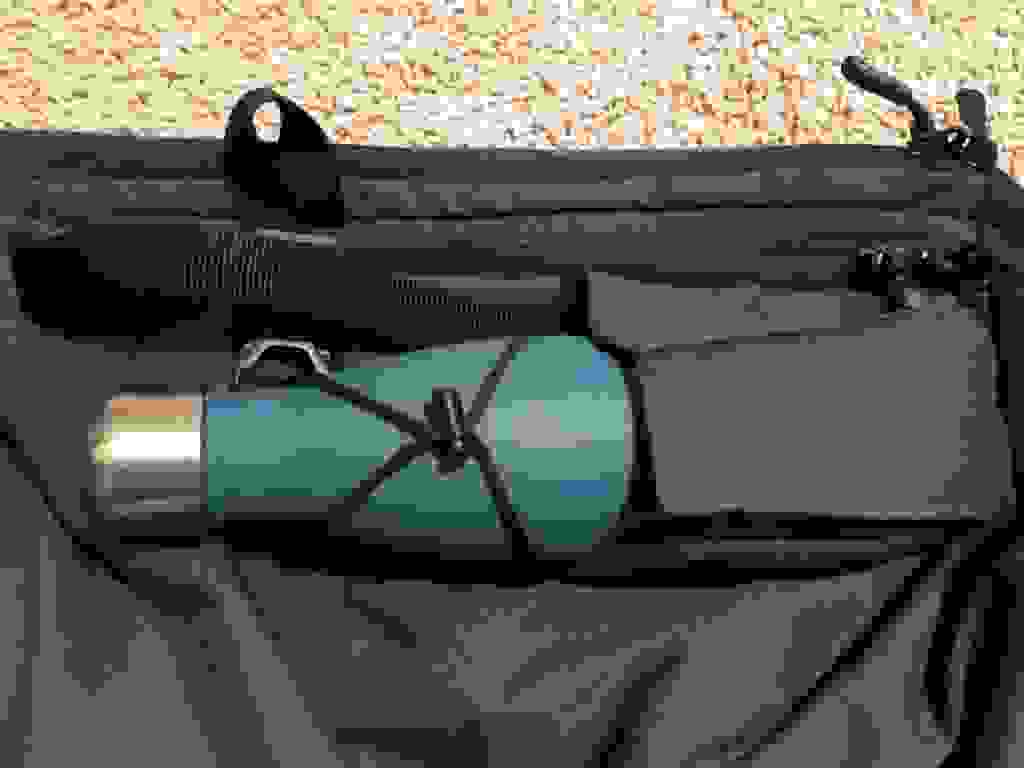
This allows you to hold bottles securely, even when the pack is lying horizontally in a cargo hold. As you can probably guess, it works best with tapered water bottles, like that one.
But I like storing the water bottle up here too:

Sure, it’ll take up some internal space, but it’ll keep the weight balanced, and it won’t fall out. I like using that side pockets for even smaller things, like maybe an umbrella.
There’s also a second pocket across the top, with a key clip:

If you look closely, there’s also a hidden, zippered pocket inside this one. I’d be willing to bet half the users of this pack don’t even know it’s there, because it’s hiding so well.
There’s also a hidden compartment along the bottom of the pack, which includes a detachable rain cover:
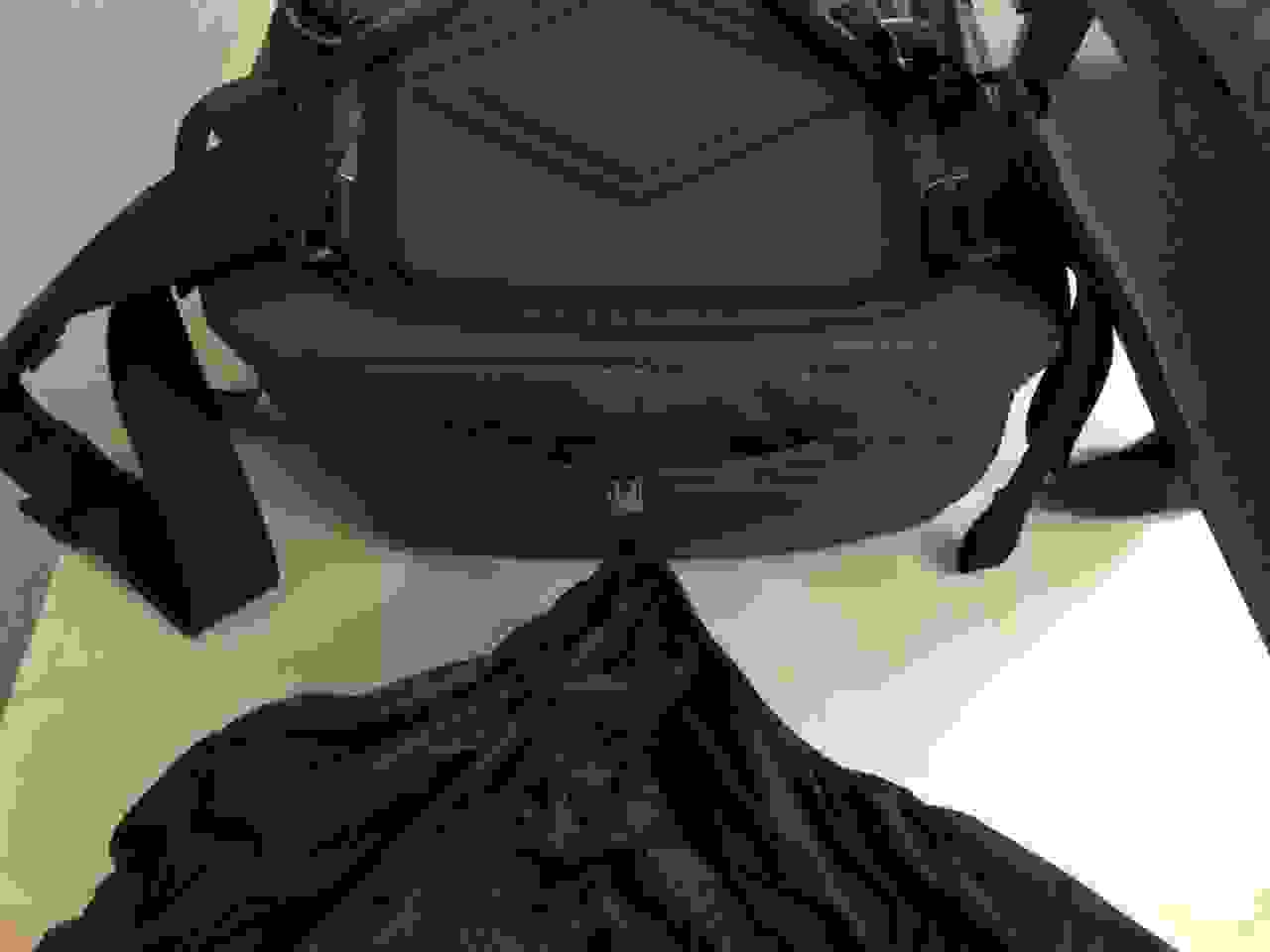
When it’s packed up inside, it forms a cushion along the bottom of the pack. It also has a tiny stuff sack built into itself, so you can store it elsewhere, or leave it at home.
(Oddly, the rain cover elastic on mine was incredibly tight; I actually switched it with the rain cover from the new Minaal Daily backpack, which was bigger for some reason. I expect this may have been a random error, and I only just noticed it…but if you get one that seems really tight, maybe send them an email about it.)
Conclusions
There was a moment a few years ago when more and more carry-on sized backpacks started showing up, and Minaal was a big part of that, with the winning combination of carry-on dimensions, suitcase-style entry, laptop protection, and rugged good looks. With this update, they’ve enhanced the functionality, by adding the padded hip belt, the 3-D organizer pockets in the main compartment, the document sleeve, and all the new clips, which make using the bag a lot simpler. Despite looking like minor tweaks, I think they’re great improvements to an already-great design.
The only things I might change would be to use a more conventional water bottle pocket with sewn-in elastic (although now that I’ve seen that elastic loop trick, I’m coming around to it), and I’d probably add a few pen or pencil slots somewhere. I might also test out U-shaped zippers on those 3-D compartments, to make them even more like packing cubes. As mentioned, the walls of the main compartment have a tendency to collapse, so you’ll want to make use of those 3-D compartments to mitigate this problem, or use a few packing cubes to keep things together. And sooner or later they should probably add more colors, because this has been doing so well that someday there’ll be six people in the same hostel with the same bag.
Certain people out there might want a larger bag, or a cheaper one; but this was designed for digital nomads who travel with a single carry-on. As such, it’s sized to accommodate the strict requirements of budget carriers, and is densely packed with lots of built-in features, which is reflected in the price. It’s easy to see why it’s been such a consistent Kickstarter success. I really like it.
So if you like what you see, get it here.
And enjoy a bonus kitty:





Any thoughts against the Tom Bihn Aeronaut (smaller one, not the 45)? At first glance, it seems this is better if you prefer the backpack more and the Aeronaut if you like a duffle more?
Yeah, that’s what I would say is the major difference. This is optimized to be a backpack first, whereas the Aeronaut is optimized to be a shoulder bag first; it has a non-padded hip belt (at least for now), a regular fabric back panel instead of mesh or something like that, and it just looks like a shoulder bag. I do like the fact that it’s convertible, though. Another strength of the Aeronaut is that you can open up all the pockets, and its footprint isn’t any bigger, whereas the Minaal requires you to unfold it, and it’s pretty long (though propping it up against a wall is helpful). Also, the Aeronaut is much more rigid and structured, so it’s easier to pack without any walls collapsing. No dedicated laptop pocket though. I don’t necessary think one design is better, as they’re both optimized with a specific purpose in mind, and they both do it quite well.
Thanks for the detailed review.
Do you have any thoughts on the Tortuga pack?
Yeah. If you want a max-sized backpack for North American airlines, go with Tortuga. Pretty much no question. The Minaal is good if you want to go a little smaller and use it as a carry-on on the more strict airlines, but if you want the maximum available space on the more lenient carriers, I think Tortuga is probably the way to go. You can also conceal its straps to use it as a checked bag in case you do run into those budget airlines. I think the Rick Steves Convertible Carry-On has a similar set of features, and it’s half the price, although I think Tortuga uses a tougher fabric, so I expect it might hold up better over time. The only other option would be if you want something that you’re going to use as a shoulder bag, in which case I like the Tom Bihn Aeronaut.
How about the Tortuga Air? Any thoughts?
I like the overall design, but it’s missing a hip belt. That was deliberate, so that people of any torso size could use it, and it’s smaller, so you’re not going to be carrying heavy loads. But even if it’s just 25 liters (and it expands to 37), it can still get pretty heavy if it’s full. Bigger people will be able to handle it just fine, but I’m small enough that I wish it had a detachable hip belt just like this one. But aside from that, I think it’s great.
Is the Tortuga too big to risk as a carry-on internationally?
For certain budget airlines, yes, but that’s why it was designed to store its backpack straps behind a panel, just like the Minaal. Occasionally you might be able to squish it into the measuring device anyway (it’s only a matter of inches or half inches), but it’s worth thinking about. Tortuga built the smaller Tortuga Air for this and other reasons, although that one doesn’t have a hip belt, so it might get tiring to carry it around all the time, especially when it’s full.
My partner Simon has been travelling with the Tortuga full-time for about 18 months and has had no problems on budget airlines including Ryanair and Easyjet in Europe and Air Asia, Tiger, and Jetstar in Asia. He definitely recommends it.
I saw that post, and I definitely like the Tortuga. If you’re going to get a 45 liter pack, there’s not much reason to get anything else. I’ve also heard of people traveling with the REI Vagabond 40, which for some inexplicable reason is 2″ longer than regular North American airline limits, and they seem to get away with it just fine. Under-packing it just a bit is a good way to be able to squish it into the carry-on measurement requirements in case an overzealous ticket agent wants to check the size.
Eytan, Thanks for yet another detailed review. Have you ever looked at the Patagonia Transport MLC Travel Backpack? It is another less than max size backpack, carry-on. I travel more on business than pleasure and have been eyeing it for my next bag.
There’s a lot that I like about the overall design, but I couldn’t live without a hip belt. If you want it to be a shoulder bag, or you’re big enough to use just the backpack straps, then I think it great. Another one to look at would be the Tom Bihn Aeronaut, which is lacking the laptop compartment, but some people like to use a separate smaller backpack anyway.
Great review of this, Eytan! I ordered one (along with all the optional straps, belts, and packing cubes they offered in their most recent Kickstarter at the end of 2015) and am glad your review reinforced a number of the things that led me to purchase this. While I have more one-bag travel gear from more brands than I could ever use (a hobby?), this latest Minaal seems a good addition.
Any thoughts to the weight / quality / strength / hair stickiness of the fabric or how the laptop compartment may help maintain its shape so things placed inside it do not get crushed?
Thanks!
Pet hair does stick to it, but I don’t find it to be a big deal. Maybe if you have dogs that shed light-colored hair all over, it might be a nuisance, but otherwise, I wouldn’t worry too much about it. When you’re on the road it’s going to get dusty sooner or later anyway. If there’s something else out there that fixes it, great, but in the meantime, it’s not going to ruin my day. It’s a tough fabric with a soft feel, without the shiny synthetic appearance of some other types.
The laptop compartment does give it some extra structure, although the foam back padding is fairly stiff already. I think the use of packing cubes is a good way to keep things from getting squished, since packing cubes basically nudge you into pre-packing inside little boxes, so you don’t get so many unsightly bulges sticking out, and it also provides more structure.
I was an early Kickstarter backer thanks to your earlier review of their first bag, and this makes me even more excited for when my carry arrives! Would love to see any feedback you get from Doug & Jimmy from your early preview.
Can you do a review of this: http://www.pacsafe.com/venturesafe-45l-gii-travel-backpack.html
I’ve handled it in a store, and it definitely has great security features, especially with those theft-proof zippers. I usually like a few more pockets on the outside, for small things like sunglasses, an umbrella, a book, and so on, and this doesn’t have that. I can see why they chose to do things that way, as they were trying to make the pack as secure as possible, without having to put multiple locks all over the place. I suppose you only need to lock it when you leave it back in your room, so maybe while you’re walking around you can just leave it unlocked, and then it’s easy. I think it’s a solid design, aside from the relatively small number of pockets, but it’s a pros and cons thing which gains you lock simplicity.
The only other one I know of that has theft-proof zippers would be Numinous Packs, although at the moment they don’t have one in this size range.
By the way, theft-proof zippers work by having teeth on both sides. They’re basically just regular “coil” zippers, which you’ve probably seen before (they’re found on almost all good outdoor gear and backpacks), but with coils on both sides. It’s neat how it works.
This is the first in-depth look at the Carry-On 2.0 that I’ve seen. Congratulations on being able to break the news.
Will you be reviewing the Daily as well?
Maybe. I like it a lot, but it’s fairly simple and self-explanatory, so I don’t know if a full review would be all that useful. The only thing that’s missing is a water bottle pocket, but there’s a grab handle on that side, and full-length zippers, so there’s no room for it. It would have required removing one of those other features to free up the space. Got any questions on it?
So besides the lack of water bottle pocket, is it identical to the 2.0? How much does it weigh?
I like that it can be converted to a appropiately-sized, nice-looking briefcase for work and am thinking of using it for travel too (I’m a light traveler).
It’s very similar; aside from the lack of water bottle pocket, it has no hip belt (which I think is fine for a pack that size), and it has one outside zip pocket instead of two, though it does add some pen slots and small pockets for credit cards and other small items on the inside of one of the zippered slots in the main compartment (which are 2D instead of 3D, though that’s fine for something this size, too). It also uses a different method to stow the shoulder straps, but it works just fine. It weighs 2 lbs, 6 oz. I like it a lot. Very simple, professional-looking, functional, and convertible into a briefcase. It’s a good daypack size, and maybe an overnighter or a weekend trip size if you’re packing light.
wish the daily had molle / attachments points for umbrella / tripods or a place to hang things off the bag like a towel.
are you aware of any workarounds ?
Yeah, the grab handle on the side. It’s not much, but it should work well enough for one or two things.
oh well, Heimplanet monolith is the other bag i’ve come across with daily’s backpack /briefcase mode. but Minaal looks a lot more professional.
Any thoughts on the Timbukt2 Aviator Convertible Travel Backpack http://www.timbuk2.com/aviator-travel-backpack/522.html It seems like it would fall into a similar category as the Minimal. The look is understated. It built with quality materials. It has a decent looking hip belt. It is heavier, which seems to be an issue for some people based off of internet reviews. Your thoughts would be greatly appreciated.
I like the overall design a lot, but I wish it were lighter, and bigger. I tried it out in a store, and it just feels so heavy for a pack that size, and since it can’t carry that much, it’s better for lighter loads…but it’s not that great for lighter loads, since it’s heavier. It has a lot of extra straps and decorative elements stitched in that look like they’re adding some weight here and there. So I think the layout is good, but I’d like to see a 35 liter version that’s only 3 pounds.
Thoughts on the GORUCK?
http://www.goruck.com/gr1-black-/p/GEAR-000574
Trying to decide between the new Minaal and a GORUCK — needs to work on European discount airlines, do a good job protecting a laptop, look good in meetings and still be a comfortable backpack with padded waist belt to hike around with for an under 5’5″ human. I have an older Rick Steves backpack and it’s been good, but think more structure would be welcome.
Thanks.
There’s a lot that I like about it, but it’s expensive, heavy, and has a weird hip belt. Aside from that, I like the overall design, and plenty of people like it. The hip belt might work fine, but it’s clear that it wasn’t designed with one to begin with, and they had to figure out a way to attach a hip belt using the existing straps. They don’t even list the weight on the site, but the 40 liter version is over 5 pounds, which is 2 pounds heavier than anything else that size. They’re using super-tough materials, but that’s still really heavy.
A lot of this comes down to personal preference, but those are the biggest issues for me with the design. It also doesn’t have too many options for pockets that are easily accessible from the outside, although it does have some internal pockets, so that helps.
By the way, check back here in a day or two and there’ll be a review for something you might like.
Good for me to consider the weight more carefully, especially as my Rick Steves is very light and my other point of reference is a Gregory daypack which weighs almost nothing until I fill up the 3L water bladder. Will look for the new review!
Thank you for this review! I’m really liking a lot of the improvements they’ve made.
I’ve been considering this pack for a while, but being on the smaller side it’s hard to find something that would fit with the hip strap at the right place and not tower over my shoulders. If it’s not too much trouble would you mind appending the review with modeling views of the Minaal 2.0 worn on people of different height? Preferably including someone towards the 5-foot end of the spectrum? Thank you!
Hmm…I actually don’t have any easily-accessible friends who are that size, though I wear a men’s size small, and I think the straps work quite nicely for somewhat smaller people. One of the things this pack does differently is that its backpack straps don’t emerge from the very top; they attach a few inches lower, and they use those stabilizer straps to pull the very top of the pack closer to your back. This means they won’t tower over your shoulders as much as others.
The distance from where the straps attach to the pack to the top of the hip belt is 15 inches, and the distance all the way to the very base of the pack is 18.75 inches, so hopefully you’ll be able to compare something you’ve got at home to those numbers.